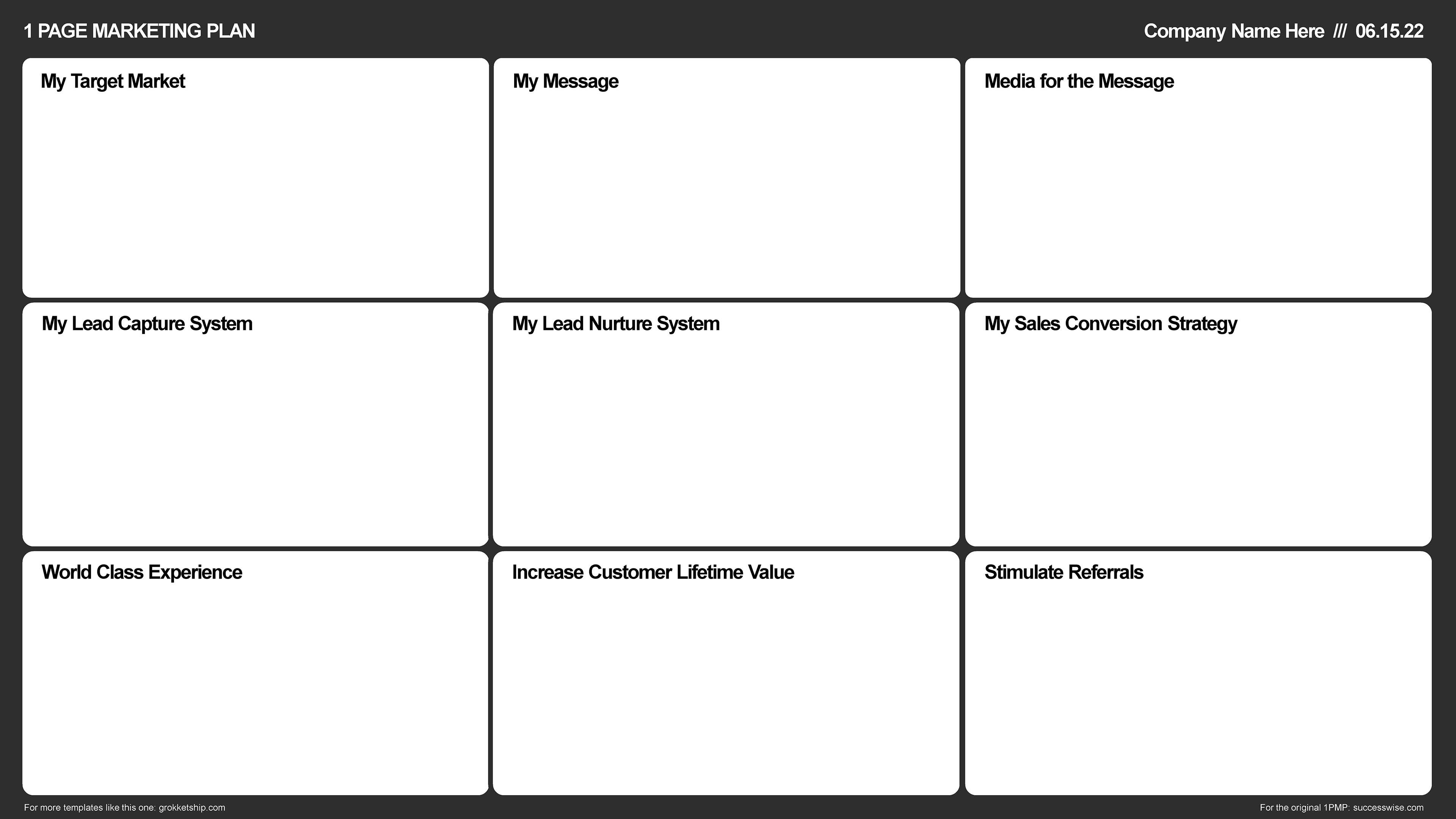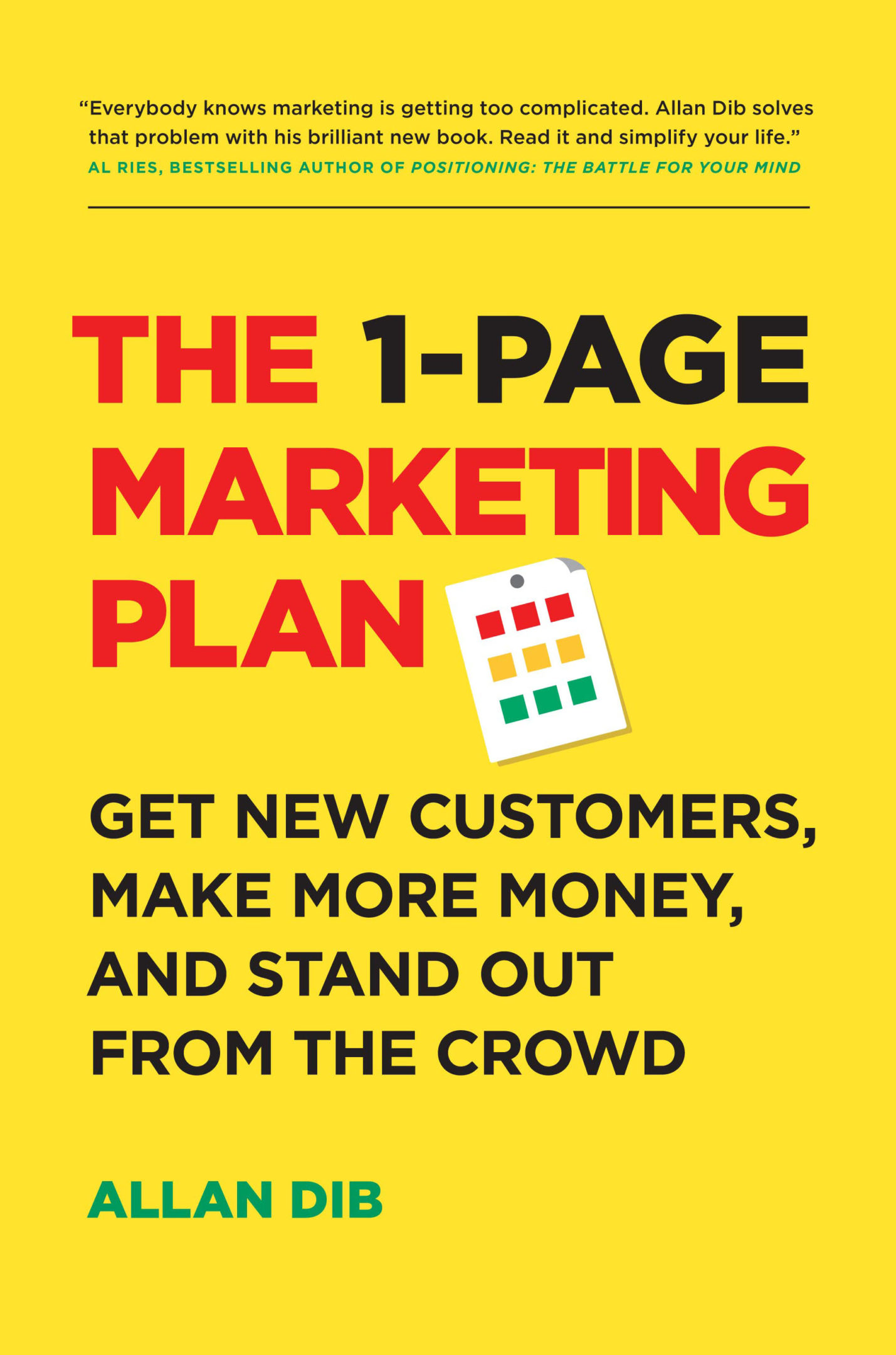
1-Page Marketing Plan Summary
Allan Dib will be quick to tell you that the book itself combines the ideas of a lot of other books into one. What he feels is unique is his 1-Page Marketing Plan canvas, which captures all those ideas onto one page. Please note this is more geared toward a small working businesses, not testing business ideas, like Lean canvas.
Introduction
Vilfredo Pareto 80/20 rule.
Apply it twice over to your time …is the 64/4 rule.
Marketing as defined by Allan Dib
- If the circus is coming and you paint a sign saying the circus is coming that’s advertising.
- If you put the sign on an elephant and walk it into town that’s promotion.
- If the elephant walks through the mayors flower bed and the news covers the story that’s publicity.
- If the mayor laughs about it that is public relations.
- If the citizens go to the circus and spend a bunch of money that is sales.
Don’t try to market like a big company
Large companies are in a different life cycle stage, have a different agenda and a different budget. Don’t try to copy them and compete on their terms.
Small and medium business marketing:
Everything must be trackable and measurable.
- Use compelling headlines and copy.
- Target specific audience for niche.
- Make a very specific offer.
- Demand a response.
- Include multi step short-term follow up.
- Incorporate maintenance follow up of unconverted leads.
The 1-Page Marketing Plan has three phases:
- Before
- During
- After
BEFORE
Chapter 1 – Selecting your Market
Niche marketing
Allows the most effective use of resources both time and money. Which should ideally be narrow and deep. This also helps make price irrelevant to identify ideal customer per Frank Kern:
- P – personal fulfillment
- V – value in the marketplace
- P – profitability
Create an Avatar (detailed persona)
Most Sales Development Reps (SDRs) call this an Ideal Customer Profile (ICP). The more narrowly defined, the better.
Chapter 2 – Crafting Your Message
Most business owners think the purpose of their ads is branding (“getting the name out there”) letting people know about their products and services, making sales and getting people to call for a quote. These are all very different and you cannot possibly do all of these in one ad. By trying to maximize the dollar they try to do too much and they end up achieving none of the above.
The rule thumb is one ad equals one objective
- If you confuse them, you lose them.
- You must be able to explain your product and the unique benefit it offers in a single short sentence. iPod: 1000 songs in your pocket.
- You MUST be CLEAR
Be clear about what they should do next and what they will get in return
The “call to action” needs to provide multiple ways to take that action from call email online mailing coupon etc. The ad should be focused on serving customer’s needs, not talk about how great you are.
Develop a Unique Selling Proposition (USP)
- Think of marketing as an amplifier. If one or two people are not interested in what you do telling 10,000 doesn’t create a different result.
- Answer the question: why should I buy from you rather than your nearest competitor? Quality and great service are expectations. They only establish parity, not something unique.
Do not try to compete on lowest price
- There’s always someone willing to go out of business faster than you. Page 58
- You want to make sure people are comparing apples to oranges.
- Develop a USP, deliver on it and make those you deal with play your game on your terms.
Create your elevator pitch
This is longer than your one sentence user USP. Bad marketing is highly product focused and self-focused. Good marketing, especially direct response marketing, is always customer / problem solution focused.
Three sentences:
- A question about the problem that starts with “you know how there are…. or…you know how most people…”
- A statement of what you do.
- An example of someone who did not do that and got screwed or did buy your product with amazing results.
Example: Do you know when there are power outages that bring down critical systems and large businesses? Well, what I do is install backup power systems for companies that rely on having a continuous supply of power for their operations. In fact I installed the system at XYZ bank and they’ve had 100% uptime since the system was installed.
Craft your offer
Questions:
- What is my target market really buying question insurance for peace of mind?
- What’s the biggest benefit to leave with?
- What are the best emotionally charged words and phrases that will capture and hold the attention of this market?
- What objections do my prospects have and how well I saw them?
- What outrageous offer/guarantee can I make?
- Is there an intriguing story I can tell?
- Who else is selling something similar and how?
- Who else has tried selling this target market something similar and how has that effort failed?
What does my target market want?
- Purchasing is done with emotions and justified with logic after the fact. You must supplement asking with observing. People who buy expensive luxury cars say they want quality liability and comfort but they really want status.
- Henry Ford said if I asked people what they wanted they would’ve said faster horses. What needed to be revealed was they actually wanted to simply get places faster.
- Look at products in categories that are trending on Amazon and eBay. Use Google ad words keyword planner. See what topics for training on social media and industry new sites.
Create an irresistible offer
- What is the most valuable thing you can do? What is the result?
- Sell lifestyle jargon here with innuendos, not features, benefits and specifications
- Reason why. Clearing of all stock. Damaged inventory.
- Personally experienced the problem myself.
- Value stacking. That’s not all…blah, blah, blah
- Tack on a service that is higher margin once they buy into the low margin item.
- Payment plan. Discounts for lump sum payment upfront.
- Satisfaction guaranteed is not good enough. Make it a risk-free transaction.
- limited time offer.
Target your customer’s pain points
People are more willing to pay for a cure than for prevention. Targeting existing pain rather than promising future pleasure will result in much higher conversion.
- Allan Dib Tweet
Copywriting for sales. You can’t bore people into buying.
He says to avoid phrases like “best” and “synergistic” and “strategic alignment.” Use words that you would use in conversations with friends. Doesn’t believe in sounding “professional.” Too boring and doesn’t stand out. People respond pictures and videos of other people. Choose words that have big emotional triggers as outlined on page 71. The five major motivators of human behavior are
- Fear
- Love
- Greed
- Guilt
- Pride
Use clickbait titles
- Proof that doctors are more dangerous that guns!
- Profits that lay hidden in your farm!
- How a Fool Stunt made a Star salesman
- Amazing secret discovered by….
Fear of loss is greater than the hope of gain.
- Allan Dib Tweet
Enter the conversation already going on in a prospect mind
- Address the enemy in common… taxes, government, no money no opportunity, etc.
- Address the elephant in the room.
- This might be security, syncing accounts, or any other obvious objection a customer might have.
Naming: Always choose clarity over cleverness.
Allan advocates something simple like “Sherman’s Plumbing Services” but I wonder if bland names are less memorable.
- Shorter is easier to remember, but for SaaS where internet presence is key, start with your URL.
- Short names that incorporate financial or money, etc. are all going to be taken.
- Clever to me is OK, IF it creates memorability.
Chapter 3 -Reaching Prospects with Advertising Media
- What gets measured gets managed.
- The basic ROI question is: did the marketing campaign make you more money that it cost you?
- Make sure you track your customer acquisition cost. This can also help you determine which marketing methods are most effective.
- Also measure the Customer Lifetime Value (CLV). If the immediate sale means they buy a printer there’s a certain amount of profit. This is called the front end. Over time however, the customer continues to spend money buying ink cartridges and support. This is called the backend.
- Generally, want your acquisition cost to be at least break even with your front end revenue, making the real profit on the backend through repeat purchases.
Ad campaign has 3 parts
- Market
- Message
- Media
Social Media Advice
Keep in mind if you’re going to play the social media marketing game you need to have someone who makes consistent and scheduled posts but also be able to respond to every ridiculous comment on every media platform at all times. Responding to comments can be time-consuming. Allan Dib is not a fan of direct social media marketing because trying to build up a following on a single platform such as Facebook or Instagram or Twitter means you’re effectively paying rent to a landlord (Facebook) who owns you and can change the rules or the rent cost at any time. Yes, you have to have a presence wherever your target market hangs out. However, he prefers direct marketing via email.
Don’t spam
When you email, be human. Write something very personal. Use a commercial email marketing system.
Email regularly
He says best practices close to weekly it says some people do daily.
Give them value
If you only email your subscriber list when you want them to buy, they will unsubscribe quickly. Most of your emails should not be sales pitches. All relationships are based on mutual value.
Automate
- How to get it delivered – To avoid spam filters don’t contain spam and phrases or too many images or links.
- How to get it opened- This is where you use the cheesy subject lines he advocates in chapter 2.
- How to get it read – Whether they are long or short depends upon the target market
Snail mail
He feels email doesn’t replace postal mail but complements it. Physical objects have a special power of moving people emotionally. Moving people emotionally toward a desired action is what marketing is all about. As much as you possibly can have an unlimited budget for marketing that works. If this creates more demand then you can fill, then it’s perfect opportunity to raise your prices.
One is the most dangerous number of your business.
One source for leads. One major supplier. One major customer. One major type of media. One type of product. This is called “a single point of failure” in the computer world. This is the very definition of a business that is brittle.
DURING
Chapter 4 – Capturing leads.
The goal of this phase is to get your leads to like you and what you have to offer enough to buy from you for the first time.
Hunting vs. Farming
According to Allan, do not try to sell directly from an ad. He feels the point marketing is to find people who are interested in what you do, put them in a database so you can build value for them, position yourself as an authority and create a relationship built on trust. When you do this, sales will naturally follow as a result.
Mining for gold with the ethical bribe
- The more money you can spend marketing to high probability prospects the better your chances are of converting them to a customer “Free DVD telling perspective brides what to look for in a wedding photographer”
- If they respond you know their name and address.
- 3% of people are ready to buy right now. 7% are opened bye maybe. 30% interested but not right now. The remaining 60% are either not interested or wouldn’t take it even if it were free, so focus on that 40%.
Automation
You must create an infrastructure to constantly brings in new leads, follows them up, nurtures and converts them into raving fan customers. Otherwise, you’re performing random acts of marketing. You must build a system, know how it works and what resources you’ll need to run it. At the absolute center is your database of customers and prospects along with the CRM system.
Chapter 5 – Nurturing Leads
Joe Girard between 1963 and 1978 sold 13,000 cars and a Chevrolet dealership. His methodology was to send a personalized greeting card every month to his entire list of customers with a note that said, “I like you”. 13,000 cards per month and he needed an assistant to help him.
He’s proposing it takes close to 12 contacts before someone will buy. He feels it’s not until contact number five you’ve become a factor in the leads mind. Contact six – gets to know you and I contact seven – you have top of mind awareness. At contact nine – if ready to buy, you have a 90% chance of being called.
- Advertise with the intention of finding people who are interested in what you do. Offer free reports video and audio with free relevant information to present solutions to problems they have that will work.
- Add them to your database.
- Continually nurture them but do not make a constant sales pitch.
- Automate the process.
He disagrees with the ABC method of “always be closing”. He feels it makes the seller a pest the prospect wants to avoid. Make yourself a welcome guest.
Your marketing mix could include:
- Lead capture website.
- Recorded messages for info.
- Newsletters.
- Blogs.
- Free reports.
- Direct mail sequences.
- Email sequences.
- Online videos.
- Podcast.
- Printhead.
- Handwritten notes.
- Email sequences.
- Email auto responders.
- SMS auto responders.
- Shock and awe packages.
Lumpy mail and the shock and awe package
This is the same cheesy one-line grabbers with a 3-D object like a magnet “attract more customers”. He feels this is vastly better than sending a link or an email or even making a phone call to prospective client that requested more information. The following ideas are expensive so you might try split tests to see what works best.
- People are conditioned to never throw books out. Powerful especially if it’s a book you wrote.
- He likes DVDs or CDs if you sell a service.
- Testimonials from past clients and video audio in written form.
- Clippings from your awards, news or mentions in the paper. If you don’t have that sent interesting news clipping about the industry.
- And then you can include your brochure sales letter or other marketing material.
- Independent white paper reports that support your service.
- A sample of the product with a coupon and gift card.
- The usual trinkets and gifts that I just stain like coffee mugs and pens. He suggests iPads for a higher dollar target.
- Handwritten notes thanking them and inquiring or recapping our conversation.
Become a prolific marketer
Make a lot of different offers to get a sense of what works and what doesn’t. Split testing. The more rapidly offers the faster you find what’s going to be a hit. Three primary types to recruit in a business:
- The entrepreneur (leader) – This is the person with the vision who hires all the right people to get the business running
- The specialist – This is the implementer the engineer the coder and or the venture capitalist. They make the vision a reality
- The manager – This is who comes in every day to make sure things get done work it’s delivered television is on track. They make sure perfect implementation reoccurs every day.
Marketing calendar
Daily, weekly, monthly, quarterly, and annually. Have a process for newly met potential prospects, inbound sales inquiries, subscribers to your blog, and customer complaints.
It’s possible to make more money but you can’t make more time. If someone else can do it 80% as good as you can, then you should delegate it.
- Allan Dib Tweet
Outsource internationally
Upwork.com
Chapter 6 – Sales Conversion
Keep in mind you’re starting the relationship in the negative. A salesperson is not to be trusted.
- Position yourself as industry leader and then deliver on that. Most businesses try to sell without first putting trust in the relationship. This is a mistake.
- If you propose marriage on the first date imagine the quality of the person who would actually say yes. Ouch!!!
- Using such a direct approach you will get a limited number of people that ask you to send a quote, ask more about a product, or say “send me information.” Then after weeks of this you get the silent treatment. This means you’ve been living on a drug called “Hopeium,” hoping that you will close the sale when there’s not enough relationship foundation for it to occur.
- You must see yourself as an educator.
Manufacturing trust
Most people do use large dumb companies with poor service and indifferent staff with out of touch management. Better the devil you know than the devil you don’t. The best you’ll get as a small company is a cursory glance and you’ll be judged by your cover.
Website Tips
- He feels failing to list the physical address and not having a privacy policy and terms of use makes you look small.
- Use a one 800 vanity number
Internal management
- CRM system
- Ticketing system
The outrageous guarantee needs to specifically address the fears of a potential buyer.
Pricing Strategy
He doesn’t offer much help here beyond being slightly lower than the market leader as a starting point.
Options
Generally, he thinks they’re a bad idea and that options should be limited. Maybe some options but not too many. Maybe only a standard and a premium version. Premium version really expensive. Some people want the best and they determine “the best” by price. Do not discount. Invite people to try before they buy.
Sales prevention department
Red tape, lengthy forms, inflexible rules and government departments. Cash only. We don’t except AMEX. $10 minimum for credit cards.
People are more attached to present money than future money. This is why offering financing or monthly payments works very well.
AFTER
Chapter 7 delivering world class experience
Build a tribe of raving fans
- Seth Godin wrote a book about this called Tribes
- Sell people what they want but give them what they need.
- Follow through with product implementation not just the sale of the product.
- Examples: Set up an online Apple style “genius bar” where people can get answers. Innovation can go beyond the actual product. Look at the way it’s priced, financed, packaged, supported, delivered, managed, marketed, and the entire customer experience as it’s delivered. People want to be entertained. See the Blend Tech “will it blend?” videos where they blend everything from iPhone to golf balls. Create theater around your products or services.
Use technology to reduce friction
Make the payment process easy
He could each piece of technology is an employee. What am I hiring this employee to do what are its key performance indicators?
Become a voice of value to your tribe
- Don’t spend most of your time on the voices that don’t count. Tune out the shower voices.
- Most valuable commodity is reputation.
- Tell your audience about all the effort that goes in delivering your product or service.
Systems
Products make you money, but systems make your fortune. 4 areas to systemize:
- Marketing
- Sales
- Fulfillment
- Administration
Systems allow scalability, create consistency, lower labor cost. Ultimately you want to fire yourself (replace yourself with a system). Break everything down to small step-by-step tasks.
- Identify the rules in your business.
- Define what task each role performs.
- Create checklist for properly completing this task.
Make sure every action you take can be framed in terms of whether it will help you create a sellable business. You’ll never make as much money running a business as you will by selling a business.
Chapter 8 – Increasing customer lifetime value
Best customers are existing customers.
- Raise prices – Self explanatory.
- Upselling – Would you like fries with that?. If you’re buying something expensive you can and sell cheaper accessories because they are comparatively so much less. Tell people, “Most customers who by X also by Y.” This is a particularly effective psychology on Amazon.
- Ascension – Move existing customers to your higher value, higher margin products and services.
- Frequency – Send purchase reminders and give them a reason to come back. Automated subscriptions.
- Reactivation – Call old customers that have left
Track your sales metrics
- Leads
- Conversion rate
- Average transaction value
- Breakeven point
On page 192 he shows example of how a .5% difference in conversion rate with a 10% price increase could quadruple profit.
Big doors swing on little hinges.
- W. Clement Stone Tweet
Also track your:
- Monthly recurring revenue (MRR)
- Churn rate
- Customer Lifetime Value (CLV)
Not all revenue is equal. Do you want raving fans as customers. The customer base can be divided into four categories
- Tribe
- Churners
- Vampires – Fire problem customers. Don’t give squeaky wheels oil. Fire them.
- Snow Leopard – This is your biggest costumer makes up most of your revenue pays a lot of money is wonderful and fun and great to work with. They’re bad investment because they don’t represent a great growth strategy.
Measure your Net Promoter Score (NPS)
Your NPS is defined as a survey that asks, “How likely is it you would recommend [our company/service/product] to a friend or colleague?”
Chapter 9 orchestrating and stimulating referrals
Ask for referrals. One of the reasons were able to keep the cost for service town is because we get a lot of our business through referrals from people like you. Will be happy to provide a gift card of $100 off the first consultation (this makes them look good)
Or…
We’re going to do an awesome job for you, but I also need your help. Most of our new business comes to referrals. That means instead of paying for expensive advertising, we live on referrals and pass the cost savings to you. Typically, we get about three referrals from each new customer. When we’re finished working together and you’re 100% satisfied, I would really appreciate if you could keep in mind three or more of the people we could also help.
Conquering the bystander effect.
This is the problem by which bystanders watch a disaster and assume someone else, but not them, will help. No one helps.
By being specific you can get people to help. I want to someone and say can you call an ambulance instead of can somebody call ambulance. For example, if you are a real estate agent, instead of asking, “If you hear of somebody who needs to buy a house,” be more specific with your offer and how you can help. “If you know someone who’s looking to buy or sell property or who’s retirement age or has recently lost her job, I’ve put together a special report titled blah blah blah blah blah. Please call or text me and I’ll send you a copy of the report to pass on.”
You should not ask for their contact information.
Joint ventures – who else shares your client base in a non-competing industry?
This is where you create a joint venture or JV. You can try to provide a commission or a referral fee, but if that is illegal or problem you can also provide a discount to make someone look good. If you own a pet supply store, find out what dog food the local veterinarians recommend. Provide coupons the vet they can give out for that specific dog food. This makes the vet feel like he’s doing something good for his customers and he’s also supporting your business.
Other JV ideas:
Seller leads. Exchanged leads. We sell complementary products and services. Become an affiliate referral partner.
Build your brand
You can’t build a brand without sales. Sales is the first step.
Summary of Summary
- Do not get stuck in analysis paralysis before implementing his plan. 80% out the door is better than 100% in the drawer.
- You must be able to delegate these tasks to other people who are specialists.
- Like all self-help book authors, he claims his solutions work for all businesses unconditionally.
- You don’t get paid for your time or effort. You only get paid for your results.
- An enormous amount of your success is dependent on the vehicle you choose. If your business is a jalopy, adding marketing is like putting lipstick on a pig. It is important to understand whether your industry is in sunset or sunrise.
- Almost all the value of the business is in the eyeballs it has access to, any customer base it has acquired. He feels if you control the customer base you control the market. His examples are Facebook, Airbnb, Alibaba and Uber.
- No one knows how good your products and services are until after the sale. Before they buy, the only thing they know is how good your marketing is. The best marketer wins every time.

YOUR BUSINESS AS MODELED BY YOU! Download you very own easy to edit PowerPoint version of The 1-Page Marketing Plan here.
Further Info
- You can download a high-res PDF of the original 1-Page Marketing Plan canvas directly from the Successwise website.
- And of course please make sure to buy a copy of this book by clicking the purchase link below:

Author Bio
Benjamin Arritt

Share:
Follow Us:
Most Popular


10+ PERSONAL CRM OPTIONS REVIEWED

10 OUTSOURCED BDR SALES AGENCIES COMPARED

FRACTIONAL MARKETING: EFFICIENT BUSINESS GROWTH
Subscribe To Our Newsletter
No spam. Curated directories & articles about business, startups and templates.
MENU
Related Posts

How to Build a High-Performing Marketing Stack for CMO Success
Dive into our blog post to learn how chief marketing officers can transform from brand champions to revenue drivers and customer whisperers through a strategic

10+ PERSONAL CRM OPTIONS REVIEWED
Yes, there are “solutions,” but nothing is perfect. Here is the path of what I evaluated, what I liked, what I didn’t and why. I

10 OUTSOURCED BDR SALES AGENCIES COMPARED
I interviewed several of the top performers according to Clutch, but this was not my exclusive source. Here’s why: some smaller companies, without as much

FRACTIONAL MARKETING: EFFICIENT BUSINESS GROWTH
Fractional marketing involves hiring fractional marketers, or part-time marketing professionals. This way businesses can leverage specialized expertise while reducing the costs associated with a full-time
